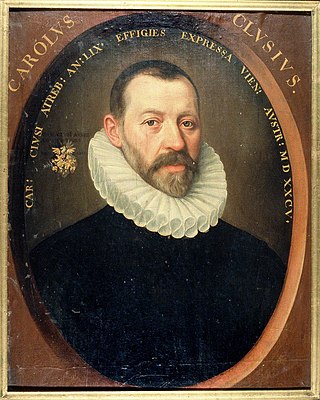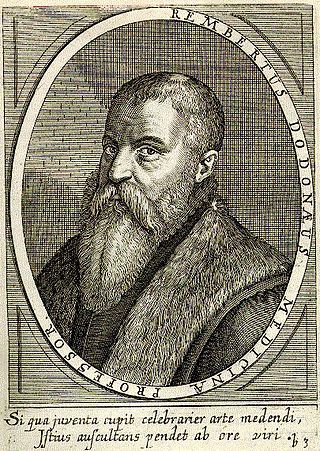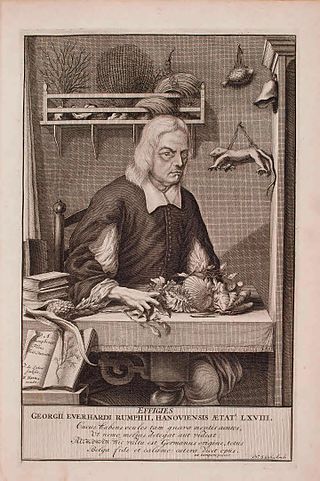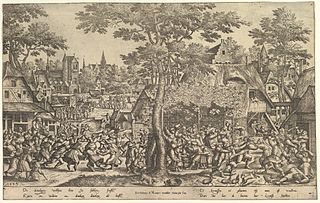Related Research Articles

Conrad Gessner was a Swiss physician, naturalist, bibliographer, and philologist. Born into a poor family in Zürich, Switzerland, his father and teachers quickly realised his talents and supported him through university, where he studied classical languages, theology and medicine. He became Zürich's city physician, but was able to spend much of his time on collecting, research and writing. Gessner compiled monumental works on bibliography and zoology and was working on a major botanical text at the time of his death from plague at the age of 49. He is regarded as the father of modern scientific bibliography, zoology and botany. He was frequently the first to describe species of plants or animals in Europe, such as the tulip in 1559. A number of plants and animals have been named after him.
This article contains information about the literary events and publications of 1618.
Events from the year 1517 in literature.

John Gerard was an English herbalist with a large garden in Holborn, now part of London. His 1,484-page illustrated Herball, or Generall Historie of Plantes, first published in 1597, became a popular gardening and herbal book in English in the 17th century. Except for some added plants from his own garden and from North America, Gerard's Herbal is largely a plagiarised English translation of Rembert Dodoens's 1554 herbal, itself highly popular in Dutch, Latin, French and other English translations. Gerard's Herball drawings of plants and the printer's woodcuts are mainly derived from Continental European sources, but there is an original title page with a copperplate engraving by William Rogers. Two decades after Gerard's death, the book was corrected and expanded to about 1,700 pages.

Martin Lister was an English naturalist and physician. His daughters Anne and Susanna were two of his illustrators and engravers.
When speaking of 1550s architecture there are many things to consider. Some may think of specific leaders, towns, or events that influenced the buildings around them. Others may immediately go to the buildings or architects or even thriving towns at the time. There is so much history from the time period lets get into some of the details...

Charles de l'Écluse,L'Escluse, or Carolus Clusius, seigneur de Watènes, was an Artois doctor and pioneering botanist, perhaps the most influential of all 16th-century scientific horticulturists.

GiacomoBarozzida Vignola, often simply called Vignola, was one of the great Italian architects of 16th century Mannerism. His two great masterpieces are the Villa Farnese at Caprarola and the Jesuits' Church of the Gesù in Rome. The three architects who spread the Italian Renaissance style throughout Western Europe are Vignola, Serlio and Palladio. He is often considered the most important architect in Rome in the Mannerist era.

Rembert Dodoens was a Flemish physician and botanist, also known under his Latinized name Rembertus Dodonaeus. He has been called the father of botany. The standard author abbreviation Dodoens is used to indicate this person as the author when citing a botanical name.

Ulisse Aldrovandi was an Italian naturalist, the moving force behind Bologna's botanical garden, one of the first in Europe. Carl Linnaeus and the comte de Buffon reckoned him the father of natural history studies. He is usually referred to, especially in older scientific literature in Latin, as Aldrovandus; his name in Italian is equally given as Aldroandi.

Georg Eberhard Rumphius was a German-born botanist employed by the Dutch East India Company in what is now eastern Indonesia, and is best known for his work Herbarium Amboinense produced in the face of severe personal tragedies, including the death of his wife and a daughter in an earthquake, going blind from glaucoma, loss of his library and manuscripts in major fire, and losing early copies of his book when the ship carrying it was sunk.

Mathias de l'Obel, Mathias de Lobel or Matthaeus Lobelius was a Flemish physician and plant enthusiast who was born in Lille, Flanders, in what is now Hauts-de-France, France, and died at Highgate, London, England. He studied at the University of Montpellier and practiced medicine in the low countries and England, including positions as personal physicians to two monarchs. A member of the sixteenth-century Flemish School of Botany, he wrote a series of major treatises on plants in both Latin and Dutch. He was the first botanist to appreciate the distinction between monocotyledons and dicotyledons. The Lobelia plant is named after him.

Sant'Andrea in Via Flaminia is a Roman Catholic church dedicated to St Andrew the Apostle in Rome, Italy. The edifice is also known as Sant'Andrea del Vignola, after its architect Giacomo Barozzi da Vignola.

Henry Lyte, also known as Henry the Elder, was an English botanist and antiquary. He is best known for two works, A niewe Herball (1578), which was a translation of the Cruydeboeck of Rembert Dodoens, and an antiquarian volume, The Light of Britayne: a Recorde of the honorable Originall and Antiquitie of Britaine (1588), both of which are dedicated to Queen Elizabeth I.
Historia animalium, published in Zurich in 1551–1558 and 1587, is an encyclopedic "inventory of renaissance zoology" by Conrad Gessner (1516–1565). Gessner was a medical doctor and professor at the Carolinum in Zürich, the precursor of the University of Zurich. The Historia animalium, after Aristotle's work of the same name, is the first modern zoological work that attempts to describe all the animals known, and the first bibliography of natural history writings. The five volumes of natural history of animals cover more than 4500 pages. The animals are presented in alphabetical order, marking the change from Middle Ages encyclopedias, or "mirrors" to a modern view of a consultation work.

Serapion the Younger wrote a medicinal-botany book titled The Book of Simple Medicaments. The book is dated to the 12th or 13th century. He is called "the Younger" to distinguish him from Serapion the Elder, aka Yahya ibn Sarafyun, an earlier medical writer with whom he was often confused. Serapion the Younger's Simple Medicaments was likely written in Arabic, but no Arabic copy survives, and there is no record of knowledge of the book among medieval Arabic authors. The book was translated to Latin in the late 13th century and was widely circulated in late medieval Latin medical circles. Portions of the Latin text make a good match with portions of a surviving Arabic text Kitab al-Adwiya al-Mufrada attributed to Ibn Wafid. The entire Latin text is very heavily reliant on medieval Arabic medicinal literature; and it is essentially just a compilation of such literature. It is exceedingly clear that the book was not originally written in a Latin language.

In folklore, the lepus cornutus or horned hare is a type of hare or rabbit that in the 16th, 17th and 18th centuries was believed to exist, but is now considered to be fictional.

Pieter van der Borcht (I) or Peter van der Borcht (c. 1530–1608) was a Flemish Renaissance painter, draughtsman and etcher. He is regarded as one of the most gifted botanical painters of the 16th century. Pieter van der Borcht the Elder also introduced new themes, such as the "monkey scene" (also called singerie) into Northern art.
References
- 1 2 3 Grun, Bernard (1991). The Timetables of History (3rd ed.). New York: Simon & Schuster. p. 245. ISBN 0-671-74919-6.
- ↑ "Rembert Dodoens: iets over zijn leven en werk — Dodoens' werken". Plantaardigheden—Project Rembert Dodoens/Rembertus Dodonaeus (in Dutch). Balkbrug: Stichting Kruidenhoeve/Plantaardigheden. 2005-12-20. Retrieved 2011-11-27.
... het Cruijdeboeck, dat in 1554 verscheen. Dit meesterwerk was na de bijbel in die tijd het meest vertaalde boek. Het werd gedurende meer dan een eeuw steeds weer heruitgegeven en gedurende meer dan twee eeuwen was het het meest gebruikte handboek over kruiden in West-Europa. Het is een werk van wereldfaam en grote wetenschappelijke waarde. De nieuwe gedachten die Dodoens erin neerlegde, werden de bouwstenen voor de botanici en medici van latere generaties. (... the Cruijdeboeck, published in 1554. This masterpiece was, after the Bible, the most translated book in that time. It continued to be republished for more than a century and for more than two centuries it was the mostly used referential about herbs. It is a work with world fame and great scientific value. The new thoughts written down by Dodoens, became the building bricks for botanists and physicians of later generations.)
- ↑ Historiae animalium, Liber II: De quadrupedibus oviparis. Gmelig-Nijboer, C. A. (1977). Conrad Gessner's "Historia Animalum": an Inventory of Renaissance Zoology. Krips Repro B.V. pp. 69–70.
- ↑ Kerr, Robert (1824). A general history and collection of voyages and travels. Vol. 7. Edinburgh: Blackwood. p. 229. Retrieved 2011-11-27.
- ↑ Probert, Alan (1997). "Bartolomé de Medina: The Patio Process and the Sixteenth Century Silver Crisis". In Bakewell, Peter (ed.). Mines of Silver and Gold in the Americas. Brookfield: Variorum. p. 96.
- ↑ Cuevas Del Barrio, Javier (2007). "La evolución de las iglesias de planta ovalada. Hipótesis para la planta de San Carlo alle Quatro Fontane" (PDF). Boletín de Arte (in Spanish). 28. Departamento de Historia del Arte, Universidad de Málaga: 105–126. ISSN 0211-8483 . Retrieved 2010-12-02.
Sant'Andrea in via Flaminia es la primera iglesia de planta oval que realiza Vignola. La construyó mientras trabajaba en la cercana villa Giulia y se terminó en 1554.
[ permanent dead link ] - ↑ Nicholls, Mark; Williams, Penry (2004). "Ralegh, Sir Walter (1554–1618)" . Oxford Dictionary of National Biography (online ed.). Oxford University Press. doi:10.1093/ref:odnb/23039. ISBN 9780198614111 . Retrieved 2011-11-28.(Subscription or UK public library membership required.)
- ↑ McDermott, James (2004). "Willoughby, Sir Hugh (d. 1554?)" . Oxford Dictionary of National Biography (online ed.). Oxford University Press. doi:10.1093/ref:odnb/29599 . Retrieved 2011-11-28.(Subscription or UK public library membership required.)